Explore Vung Tau - South Vietnam Travel, Asia
Nestled along Vietnam's southern coast, Vung Tau is a vibrant city that blends natural beauty with cultural richness. Known for its stunning beaches, historic sites, and welcoming atmosphere, Vung Tau has become a sought-after destination for travelers. Whether you’re seeking relaxation by the sea, a taste of local culture, or an adventure through history, Vung Tau offers it all. Let’s take a walk through the must-see attractions, local delicacies, and unique experiences that make Vung Tau a true coastal gem.
Population: Approximately 470,000 in 2022.
Economy: Vung Tau’s economy thrives on tourism, oil and gas industries, and shipping. The city’s port plays a key role, while tourism boosts local businesses and hospitality services.
Landmarks: Famous for the statue Christ of Vung Tau, Vung Tau Lighthouse, and White Palace.
Vietnam
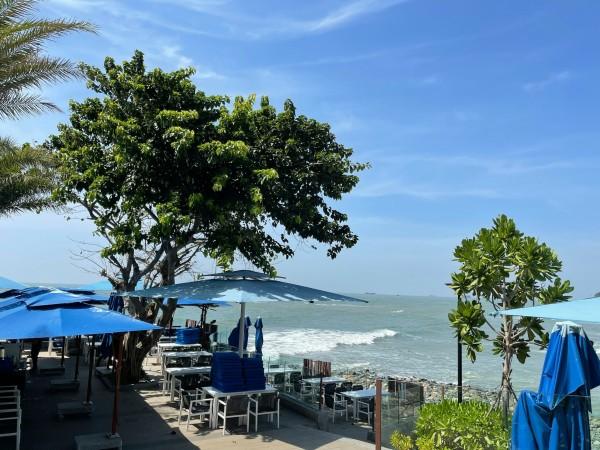
Overview of Vung Tau
History & Cultural Influence
Vung Tau's history is as rich as its landscapes. Once a humble fishing village, the city gained prominence during French colonial times, leaving behind a legacy of elegant architecture and a cosmopolitan flair. During the Vietnam War, Vung Tau served as an important military base, and remnants of this era can be explored in museums and memorials throughout the city. This blend of influences—French colonial, Cham, and Vietnamese—has shaped Vung Tau into a cultural mosaic, offering travelers a unique opportunity to step back in time while enjoying modern amenities.
Interaction with The Locals
Vung Tau is home to a population of approximately 470,000 residents, making it a lively yet manageable city. The citizens of Vung Tau are known for their friendliness and hospitality, welcoming visitors with open arms. The population is a mix of locals, many of whom have deep-rooted ties to the fishing industry, and a growing number of people from other parts of Vietnam who have moved to the city for work or its coastal lifestyle. This blend of old and new creates a vibrant community that values tradition while embracing modernity.
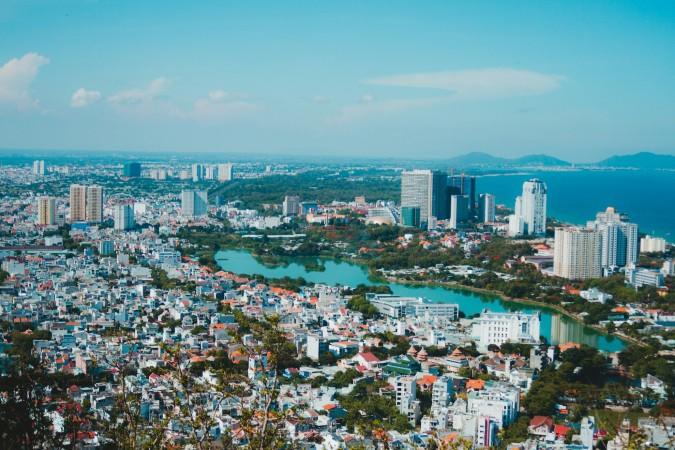
Vung Tau City - © Hữu Phú
Top Attractions in Vung Tau
Vung Tau is a treasure trove of attractions that cater to history buffs, nature lovers, and beachgoers alike. These attractions, each with its unique charm, showcase the diverse experiences Vung Tau offers.
- Christ of Vung Tau: Towering above the city, this impressive statue of Jesus Christ is one of the largest in the world. Reaching the summit affords magnificent sweeping views of Vung Tau and the surrounding shore.
- Vung Tau Lighthouse: Perched on Núi Nhỏ (Small Mountain), the lighthouse has been guiding ships for over a century. The hike up is rewarded with stunning views and a sense of history as you explore this iconic structure.
- Vung Tau White Palace: This French colonial-era villa, set against the backdrop of Núi Lớn (Big Mountain), is a window into Vung Tau’s past. Now a museum, it houses artifacts from the city’s history, including items from the Nguyễn dynasty.
- Long Hai Beach: Located just outside the city, Long Hai Beach is a quieter alternative to the main beaches. It is well-known for its pure beaches, crystal-clear seas, and the verdant background of the Minh Đạm Mountains, which is ideal for a peaceful day trip.
- Hon Ba Island: Accessible by a rocky causeway at low tide, Hon Ba Island is home to a small temple, Mieu Ba (Ba Temple), dedicated to the goddess of the sea. The island offers a tranquil escape and a spiritual experience for those looking to explore local religious practices.
- Niet Ban Tinh Xa Temple: Often referred to as the "Temple of Nirvana," this is one of Vung Tau's most exquisite and tranquil temples. It features a large reclining Buddha statue and offers stunning views of the sea from its hillside location.
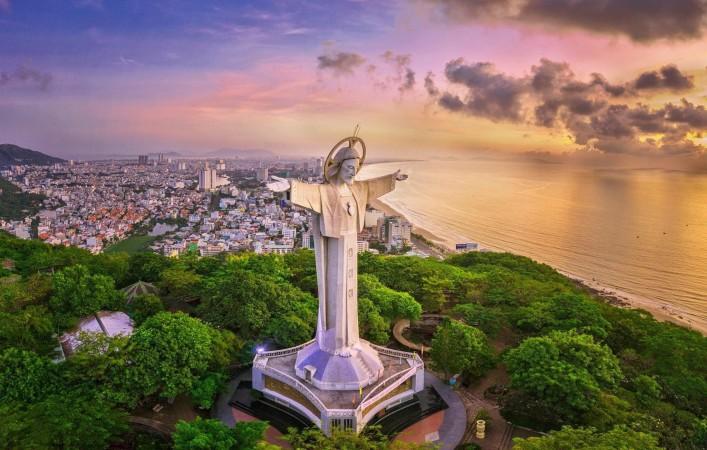
Christ of Vung Tau - © VnExpress
Must-Try Dishes in Vung Tau
Vung Tau’s culinary tradition is a delightful reflection of its coastal location and cultural influences. The city’s vibrant food culture offers a feast for the senses, from fresh seafood to traditional Vietnamese delicacies.
- Banh Khot (Mini Savory Pancake): A signature dish of Vung Tau, bánh khọt are small, crispy pancakes made from rice flour and coconut milk, topped with fresh shrimp, and served with a side of herbs and fish sauce. This dish is a local favorite and a must-try for anyone visiting the city.
- Goi Ca Mai (Vietnamese Raw Fish Salad): This traditional Vietnamese salad is made with cá mai, a small white fish. It’s marinated with lime juice, mixed with herbs, peanuts, and crispy rice crackers. The dish is light, refreshing, and perfect for those who enjoy vibrant, fresh flavors.
- Bun Sua (Rice Vermicelli with Jellyfish): Bun Sua is a noodle soup made with jellyfish, offering a unique texture and taste. The jellyfish is served in a clear, flavorful broth with vermicelli noodles and herbs, making it a refreshing choice for a light meal.
- Banh Canh Ghe (Crab Thick Noodle Soup): A comforting bowl of thick noodles served with crab meat in a savory broth. The sweetness of the crab, combined with the rich flavors of the soup, makes this dish a favorite among locals and visitors alike.
- Banh Beo (Vietnamese Steamed Savory Rice Cake): These small, steamed rice cakes are topped with a mixture of minced shrimp, green onions, and crispy pork rinds, and are typically served with a side of fish sauce. Bánh Bèo is a light, flavorful snack perfect for any time of day.
- Hu Tieu Muc (Noodle Soup Fresh Squid): A variation of the popular hủ tiếu noodle soup, this version features squid as the main protein. The clear, flavorful broth is complemented by the tender, slightly chewy squid, creating a delightful dish that’s both satisfying and full of umami.
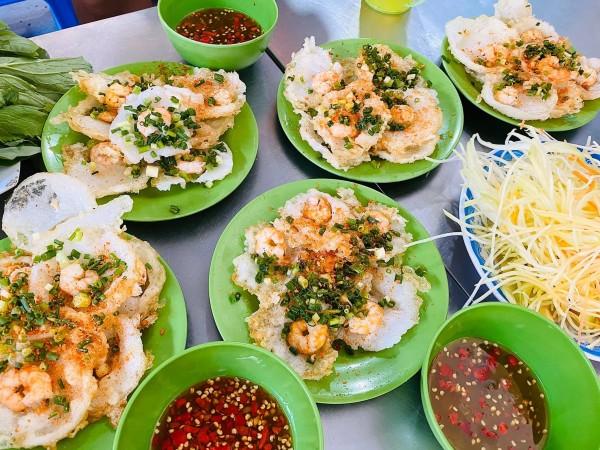
Banh Khot (Mini Savory Pancake) - © Dan Viet News
Festivals & Local Celebrations
The Whale Festival
The Whale Festival is one of the most important and culturally significant events in Vung Tau. Held annually, typically in August, this festival honors Ca Ong, the whale god, who is revered by the local fishing community as a protector of fishermen and their livelihoods. The festival features elaborate ceremonies, including the procession of a whale skeleton through the streets, accompanied by traditional music and dance. The highlight of the event is the offering of sacrifices and prayers at the Whale Temple (God Thang Tam Temple), where locals express their gratitude and seek blessings for a bountiful fishing season. The atmosphere is one of reverence and celebration, attracting both locals and tourists.
Dinh Co Festival
Celebrated in nearby Long Hai Beach, the Dinh Co Festival is a grand annual event held in February or March, depending on the lunar calendar. This festival honors Lady Dinh Cô, a local deity believed to protect sailors and fishermen. The festival spans several days and includes a range of activities such as ceremonial offerings, traditional music performances, and dragon dances. Pilgrims from all over the region flock to the Dinh Co Temple to pay their respects and participate in the rituals. The festival also features a vibrant market where visitors can purchase local goods and enjoy traditional foods. The Dinh Co Festival is a deeply spiritual experience, reflecting the community’s devotion and cultural heritage.
Do you love the dynamic features of Vietnam? Learn more about Hoa Binh here.
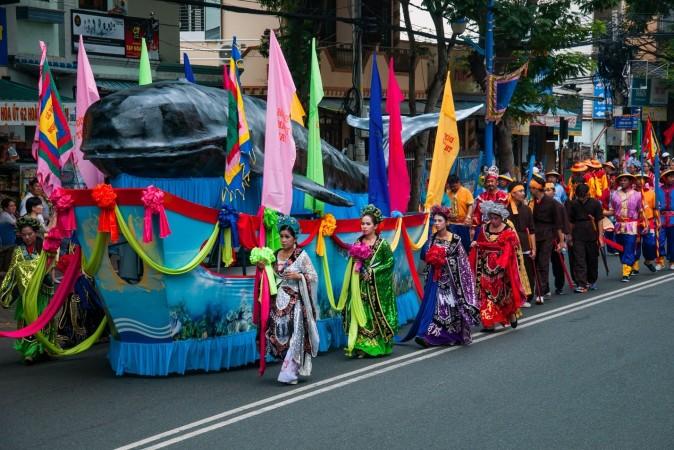
The Whale Festival - © Ba Ria-Vung Tau Official Website
What to Do in Vung Tau
- Beach Activities: With its stunning coastline, Vung Tau is perfect for beach activities. Spend a day lounging on Back Beach (Bãi Sau), swimming in the clear waters, or trying out water sports like jet skiing and windsurfing. Front Beach (Bãi Trước) has stunning sunset views, making it the perfect spot for an evening promenade.
- Hiking Trails in Vung Tau: The city’s mountainous terrain provides excellent hiking opportunities. The hiking trails at Núi Lớn (Big Mountain) and Núi Nhỏ (Small Mountain) provide stunning views of the city and sea. Along the way, you can explore the lush vegetation and encounter local wildlife.
- Historical Tours: Explore Vung Tau’s rich history by visiting its many historical sites. A tour to the White Palace, the Lighthouse, and the various war memorials can provide fascinating insights into the city’s past. If you want to learn more about Vietnamese history, Cu Chi is a must-go destination for you.
- Cultural Experiences: Immerse yourself in the local culture by participating in traditional activities. Visit a local market, where you can shop for handicrafts, fresh produce, and souvenirs. Or, take a cooking class to learn how to prepare some of Vung Tau’s famous dishes, like bánh khọt.
- Golf Tours in Vung Tau: For those who enjoy golf, Vung Tau offers several excellent courses with beautiful views. The Paradise Golf Resort is a popular choice, combining challenging play with scenic surroundings.
Shopping in Vung Tau
- Vung Tau Market: The city’s central market is a bustling hub where you can find a wide variety of goods. From fresh seafood to local delicacies, handicrafts, and clothing, this market offers a glimpse into the daily life of Vung Tau’s residents. It’s the perfect place to pick up some authentic Vietnamese souvenirs.
- Lotte Mart Vung Tau: For a more modern shopping experience, head to Lotte Mart. This large shopping mall offers a wide range of products, including electronics, fashion, and home goods. It also has a supermarket where you can find both local and international food items.
- Vung Tau Night Market: Located near Front Beach, this night market is a must-visit for food lovers. It's the ideal location to sample street cuisine, especially freshly made seafood dishes. You’ll also find vendors selling souvenirs and local crafts.
- Imperial Plaza: A high-end shopping destination, Imperial Plaza offers luxury goods, fashion brands, and dining options. It’s a great place to shop for high-quality items and enjoy a more upscale shopping experience.
- Handicraft Shops: Scattered throughout the city, these small shops offer a variety of handmade items, from ceramics to embroidered textiles. These unique pieces make for meaningful souvenirs that capture the essence of Vung Tau’s culture.
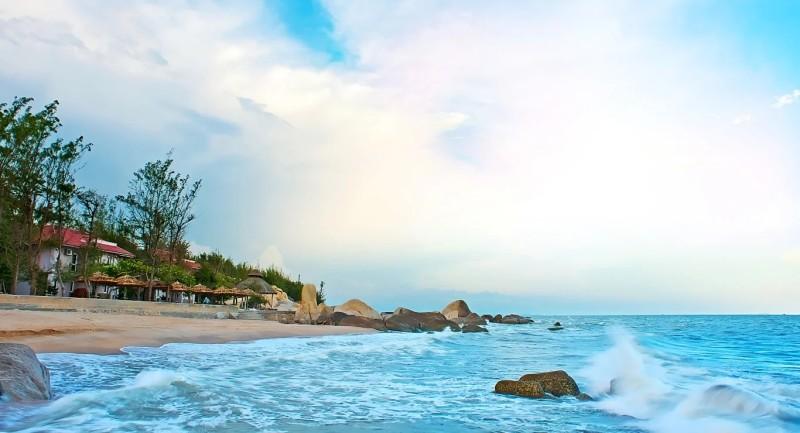
Relax at Vung Tau serene beach - © MIA
Weather in Vung Tau: Best Time to Visit
Dry Season in Vung Tau
- Weather: The dry season is distinguished by hot weather and little humidity. Daytime temperatures typically range from 25°C to 32°C (77°F to 89°F), with clear skies and minimal rainfall.
- Tourism Trend: This is the peak tourist season in Vung Tau with perfect weather for outdoor exploration, beach activities, and sightseeing. Popular attractions such as Back Beach (Bãi Sau) and Front Beach (Bãi Trước) are bustling with tourists. The dry season also sees a variety of outdoor events and festivals, making it a vibrant time to experience the city’s cultural and recreational offerings.
Wet Season in Vung Tau
- Weather: Higher humidity and frequent, but typically brief, rains are characteristics of the rainy season. The temperature remains warm, ranging from 24°C to 31°C (75°F to 88°F). Rainfall is more frequent, particularly in the late afternoon and evening.
- Tourism Trend: The wet season is considered the off-peak period for tourism in Vung Tau. Although rain is more common, it often comes in short bursts, allowing for sightseeing and activities during the dry times. This season can offer a more relaxed atmosphere with fewer crowds at popular spots. The lush, green landscape after rain can enhance the city’s natural beauty, making it a great time for nature enthusiasts and photographers.
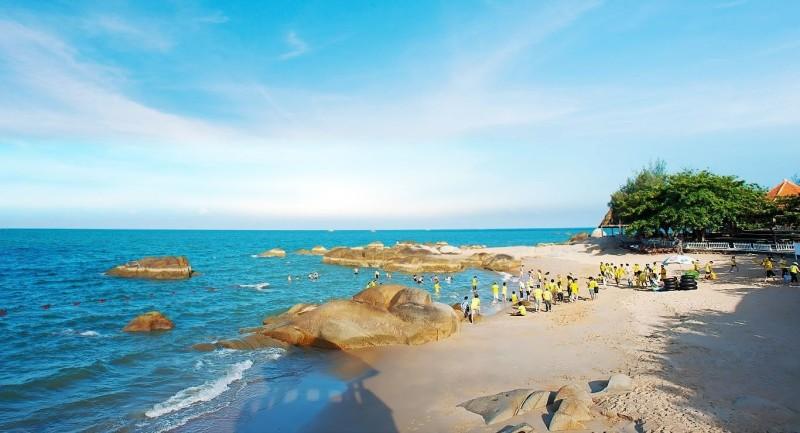
Off-peak season at Vung Tau - © MIA
Culture Etiquette in Vung Tau
- Dress Modestly: While Vung Tau is a tourist-friendly city, it’s important to dress modestly, especially when visiting religious sites or temples and show respect by covering your knees and shoulders.
- Respect Local Traditions: When participating in local festivals or ceremonies, follow the customs and observe how locals behave. For example, during religious rituals, remain quiet and respectful.
- Polite Behavior: Vietnamese culture values politeness and respect. Use polite language and gestures, such as a gentle nod or smile, when interacting with locals.
- Removing Shoes: In many Vietnamese homes and temples, it is customary to remove your shoes before entering. Look for signs or observe local practices to follow this etiquette.
- Tipping: Tipping is not compulsory but is appreciated in restaurants and for services like taxis. A small amount, such as 10,000 to 20,000 VND, is generally sufficient.
- Bargaining: In local markets, bargaining is a common practice. Engage in friendly negotiation, keeping in mind that the aim is to reach a fair price for both parties.
Essential Travel Information
Getting Around Vung Tau
- Motorbike Rentals: Renting a motorbike is a popular and convenient way to explore Vung Tau, giving you the flexibility to visit various attractions at your own pace. Make sure your driver's license is up to date, and for safety, wear a helmet.
- Taxis and Ride-Hailing Apps: Taxis are readily available throughout the city. You can also use ride-hailing apps like Grab, which provide a convenient and reliable way to get around.
- Public Buses: Vung Tau has a network of public buses that connect major areas of the city. Buses are an affordable option for getting around, though they may not be as frequent or convenient as taxis or motorbikes.
- Bicycle Rentals: For a more leisurely way to explore the city, consider renting a bicycle. Biking is a great way to enjoy Vung Tau’s scenic spots and beachfront areas.
- Private Car Hire: If you prefer a more comfortable and personalized travel experience, you can hire a private car with a driver. This option is ideal for day trips or excursions to nearby areas.
- Walking: Many of Vung Tau’s attractions, particularly those around the city center and beaches, are within walking distance. Exploring on foot allows you to fully appreciate the city’s sights and sounds. If you like taking a long walk, visiting Sapa is a place you can not miss. Read all about Sapa here.
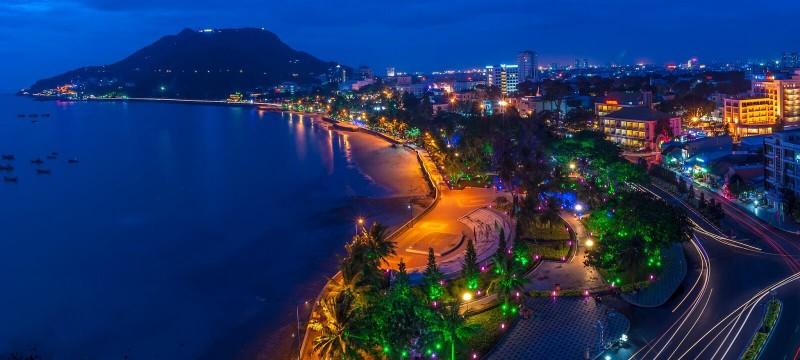
Vung Tau at night - © Vietnam Tourism
ATM & Banking Services
Vung Tau offers a range of banking and financial services to accommodate both locals and tourists. Numerous ATMs are conveniently located throughout the city, especially in popular areas such as the city center, near major hotels, and shopping districts, and they typically accept international credit and debit cards for cash withdrawals. Banking branches are also available, where you can conduct transactions, exchange currency, and access financial assistance. While credit cards are widely accepted at hotels, restaurants, and larger stores, it's wise to carry some cash for smaller vendors and markets.
Where to Stay in Vung Tau
- Luxury Hotels: For a luxurious experience, Vung Tau has several high-end hotels offering top-notch amenities and services, including elegant rooms, swimming pools, and spas at various premium properties, ocean views and gourmet dining options.
- Mid-Range Hotels: These hotels provide comfortable rooms, modern amenities, and convenient locations, often close to the beach and city center, with comfort at a more affordable price.
- Budget Hotels and Hostels: These options offer clean and simple accommodations at affordable rates, ideal for those seeking basic amenities and a central location without breaking the bank.
- Beachfront Resorts: For those who want to stay right by the sea, beachfront resorts are a perfect choice with direct beach access, stunning sea views, and recreational facilities, making them ideal for a relaxing seaside retreat.
Articles for you

Explore Yala National Park - Sri Lanka Travel, Asia
Tucked away in Sri Lanka’s southeastern corner, Yala National Park is where wild nature meets deep tradition. Known worldwide for its leopard population, the park is also home to elephants, sloth bears, crocodiles, and hundreds of bird species. Beyond wildlife, Yala opens doors to a cultural landscape dotted with ancient temples, Buddhist ruins, and coastal villages. For travelers seeking more than just a safari, Yala offers a chance to explore eco-tourism, local communities, and sacred heritage sites.
Population: The Yala National Park area doesn’t have a human population.
Economy: The economy around Yala National Park thrives on a blend of eco-tourism, agriculture, and local services. Safari tours, eco-lodges, and cultural experiences drive steady income for nearby towns like Tissamaharama and Kataragama, supporting thousands of families.
Landmarks: Famous for Block I of Yala and wildlife encounters, including elephants, sloth bears, crocodiles, and exotic bird species.

Explore Galle - Sri Lanka Travel, Asia
Nestled on Sri Lanka’s southern coastline, Galle is a vibrant city where history meets the sea. Its cobbled streets, colonial architecture, and serene beaches make it a must-visit destination for travelers seeking a blend of culture, adventure, and relaxation. A UNESCO World Heritage site, Galle captivates visitors with its Dutch Fort, bustling markets, and friendly locals. Whether you’re exploring the ramparts at sunset or savoring fresh seafood by the shore, Galle promises an unforgettable journey into Sri Lanka’s heritage.
Population: Approximately 113,000 in 2023.
Economy: Galle’s economy thrives on tourism, trade, and fisheries. The city’s historic fort, colonial architecture, and coastal charm draw thousands of international visitors each year, making tourism its main economic driver. Fishing remains vital for local livelihoods, supplying fresh seafood across the region.
Landmarks: Famous for the Galle Fort, Dutch Reformed Church & Maritime Museum, and Unawatuna Beach.

Explore Bentota - Sri Lanka Travel, Asia
Nestled along Sri Lanka’s southwestern coast, Bentota is a tropical paradise that blends golden beaches, vibrant culture, and thrilling adventures. Famous for its calm waters, luxury resorts, and scenic river estuary, Bentota has become a top destination for travelers seeking both relaxation and authentic experiences. From serene beach walks at sunrise to adrenaline-pumping water sports, this coastal town offers a perfect balance of leisure and exploration. With its proximity to Colombo and Galle, Bentota is easy to reach, making it an ideal stop for both short escapes and extended holidays.
Population: Approximately 37,000 in 2023.
Economy: Bentota’s economy thrives mainly on tourism, which drives local businesses such as hotels, restaurants, and wellness retreats. The town also benefits from fishing, coconut cultivation, and handicrafts like wood carving and batik textiles. Many residents rely on the growing demand for water sports and Ayurvedic treatments, making tourism the backbone of both income and employment in the area.
Landmarks: Famous for Bentota Beach, Bentota River Safari, and Kande Vihara Temple.

Explore Mirissa - Sri Lanka Travel, Asia
Mirissa is a charming coastal town on Sri Lanka’s southern shoreline. Known for its golden beaches, turquoise waters, and vibrant marine life, it has become a must-visit stop for travelers exploring the island. Many come for whale watching, surfing, and sunset views at Coconut Tree Hill, but Mirissa offers much more than postcard beauty. The fishing boats you see anchored by the bay carry generations of stories. Local traditions, delicious cuisine, and a laid-back rhythm of life shape every visitor’s experience.
Population: Approximately 4,700 in 2023.
Economy: Mirissa’s economy is largely shaped by its coastal location. Fishing has long been the backbone of local livelihoods, with generations relying on the Indian Ocean for income. In recent decades, tourism has become the main driver of growth, thanks to whale watching, surfing, and beachside hospitality.
Landmarks: Famous for Mirissa Beach, Coconut Tree Hill, and Parrot Rock Bridge.

Explore Nuwara Eliya - Sri Lanka Travel, Asia
Tucked away in the Central Highlands of Sri Lanka, Nuwara Eliya is often called “Little England”. With its rolling tea plantations, cool misty mornings, and colonial charm, this mountain town feels like a step into another world. Travelers come here to breathe fresh air, walk through flower gardens, sip the finest Ceylon Tea, and enjoy a pace of life far from the island’s busy cities. Whether you’re drawn by scenic landscapes, heritage architecture, or the warmth of its people, Nuwara Eliya is a destination that blends nature, culture, and history in perfect harmony.
Population: Approximately 781,000 in 2023.
Economy: Nuwara Eliya’s economy thrives mainly on tea production, as it sits in the heart of Sri Lanka’s central highlands, famous worldwide for Ceylon Tea. The city also benefits from a growing tourism industry, attracting visitors with its colonial charm, cool climate, and scenic landscapes.
Landmarks: Famous for Gregory Lake, Hakgala Botanical Garden, and Victoria Park.

Explore Sukau - Malaysia Travel, Asia
Nestled on the banks of the Kinabatangan River in Sabah, Malaysian Borneo, Sukau is a destination where wildlife, culture, and conservation come together. Known as one of Asia’s top spots for river safaris and eco-tourism, this quiet village offers a front-row seat to encounters with Bornean orangutans, pygmy elephants, proboscis monkeys, and exotic birdlife.
Population: Approximately 1,400 in 2019.
Economy: Sukau’s economy is shaped by its riverine location and natural resources. Traditionally, the Orang Sungai community relied on fishing, small-scale farming, and forest gathering for their livelihood. Today, the village has shifted toward eco-tourism, with river cruises, jungle trekking, and homestays providing income.
Landmarks: Famous for the Kinabatangan River cruises, Gomantong Caves, and Ox-bow lakes and wetlands.
